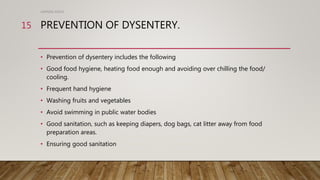Understanding Dysentery

Dysentery is a highly infectious disease that can spread quickly in areas with poor sanitation and hygiene. The bacteria that cause dysentery, Shigella, can contaminate food and water through several routes, including:
- Contaminated water sources: Floods, landslides, and other disasters can contaminate water sources, making them unsafe for drinking.
- Poor sanitation: Inadequate waste disposal and sewage systems can allow human waste to contaminate soil, water, and food.
- Contaminated food: Food can become contaminated with Shigella through poor handling and preparation practices.
- Human-to-human contact: Dysentery can spread through close contact with an infected person, especially in crowded shelters and camps.
Symptoms of Dysentery
The symptoms of dysentery can range from mild to severe, and may include:
- Diarrhea: Frequent, watery stools that may contain blood or mucus.
- Abdominal pain: Severe cramping and tenderness in the abdomen.
- Fever: High fever, often above 101°F (38.3°C).
- Dehydration: Excessive thirst, dark urine, and decreased urine output.
- Nausea and vomiting: Frequent vomiting, which can lead to dehydration.
Prevention of Dysentery in Disaster Zones
Preventing dysentery in disaster zones requires a multi-faceted approach that involves individuals, communities, and organizations working together to promote hygiene, sanitation, and safe water practices. Here are some measures that can be taken to prevent the spread of dysentery:
- Provision of Safe Water: Access to safe drinking water is essential to preventing dysentery. In disaster zones, this can be achieved through the provision of bottled or bagged water, water purification tablets, or water filters.
- Improvement of Sanitation: Proper waste disposal and sewage systems are critical to preventing the spread of dysentery. In disaster zones, this can be achieved through the construction of temporary latrines, portable toilets, or sewage systems.
- Promotion of Hygiene: Good hygiene practices, such as handwashing with soap and water, can help prevent the spread of dysentery. In disaster zones, this can be promoted through education and awareness campaigns, as well as the provision of soap and water for handwashing.
- Food Safety: Food safety is essential to preventing dysentery. In disaster zones, this can be achieved through the provision of safe food, proper food handling and preparation practices, and the avoidance of contaminated food.
- Vaccination: Vaccination against Shigella is not widely available, but it is essential to vaccinate against other diseases that can weaken the immune system and make individuals more susceptible to dysentery.
- Shelter and Camp Hygiene: In disaster zones, shelters and camps can become breeding grounds for dysentery. To prevent this, it is essential to promote good hygiene practices, such as handwashing, proper waste disposal, and proper food handling and preparation.
- Community Engagement: Community engagement is critical to preventing dysentery in disaster zones. This can be achieved through education and awareness campaigns, as well as the involvement of community leaders and volunteers in promoting hygiene and sanitation practices.
FAQs
- What is dysentery, and how is it caused?
Dysentery is a potentially life-threatening disease caused by the ingestion of food or water contaminated with the bacteria Shigella. - How can dysentery be prevented in disaster zones?
Dysentery can be prevented in disaster zones through the provision of safe water, improvement of sanitation, promotion of hygiene, food safety, vaccination, shelter and camp hygiene, and community engagement. - What are the symptoms of dysentery?
The symptoms of dysentery include diarrhea, abdominal pain, fever, dehydration, nausea, and vomiting. - How can I protect myself from dysentery in a disaster zone?
To protect yourself from dysentery in a disaster zone, practice good hygiene, such as handwashing with soap and water, avoid contaminated food and water, and seek medical attention if you experience symptoms of dysentery. - What can be done to promote hygiene and sanitation in disaster zones?
To promote hygiene and sanitation in disaster zones, education and awareness campaigns can be conducted, and soap, water, and other hygiene materials can be distributed.
Conclusion
Dysentery is a potentially life-threatening disease that can spread rapidly in disaster zones, where access to clean water, sanitation, and medical care may be limited. However, through a multi-faceted approach that involves individuals, communities, and organizations working together to promote hygiene, sanitation, and safe water practices, the spread of dysentery can be prevented. By prioritizing dysentery prevention in disaster zones, we can save lives, prevent suffering, and promote the overall health and well-being of survivors. It is essential for governments, organizations, and individuals to work together to promote dysentery prevention and control measures, and to provide support to affected communities. By doing so, we can reduce the risk of dysentery outbreaks and promote a swift and sustainable recovery from disasters.
Closure
Thus, we hope this article has provided valuable insights into Dysentery prevention in disaster zones. We appreciate your attention to our article. See you in our next article!